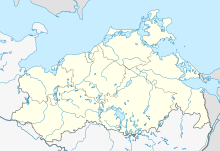Fahrbrink peninsula nature reserve
Coordinates: 54 ° 10 ′ 28 ″ N , 13 ° 20 ′ 24 ″ E

The Fahrbrink peninsula nature reserve is a nature reserve in Mecklenburg-Western Pomerania . It covers 30 hectares and is located between Riemserort and Gristow . The peninsula protrudes into the Gristower Wiek, a bulge of the Strelasund . With the designation of the protected area on November 5, 1990 and an extension in 1994, a pasture landscape with salt grassland and the surrounding bank and shallow water areas are to be protected. The protected area is divided by a dike to the west .
The state of the area is considered to be good. Birds can rest relatively undisturbed on the water surface. Drainage and embankment impair the western meadow areas, as the supply of salty brackish water is disturbed and nutrient-loving plants spread.
The area may not be entered. The elevated parking lot at the entrance to Riemserort offers a good vantage point.
history
The Fahrbrink peninsula was created as a small moraine island during the last ice age . Today's connection to the mainland was created by a coastal flood moor , which is two meters thick with fens . Human use is documented on the Swedish matriculation cards from 1692–98. They already show the areas as pastures and meadows. The higher-lying peaks were subject to a small extent to arable use, which today is made up of pines. Since the 1970s, the outer dike areas have been grazed with horses while the inner dike areas have been abandoned.
Flora and fauna
Salt marshes can be found on the unsealed areas in the central area of the nature reserve. Typical representatives are salt bulrush , beach aster , beach sedge , beach trident , beach plantain and beach sod . The higher part of the peninsula is planted with pines, in whose undergrowth grow not only hawthorn and dog rose, but also bristle grass and meadow elephant . The bank area to the north is occupied by ledges-Bodden cane with reeds , beach ledges , marsh goose thistle and common water dost . In the western part, there are reed beds.
The area is a good resting place for numerous water birds due to its location protected from wind and waves. Several thousand mountain and tufted ducks can be found in autumn and winter , as well as the humped and whooper swan and other species of duck such as mallard , golden pochard and pochard . The oystercatcher occurs in the salt marshes. 281 species of moths were detected.
literature
- Fahrbrink Peninsula 249 . In: Ministry of Environment Mecklenburg-Western Pomerania (Hrsg.): The nature reserves in Mecklenburg-Western Pomerania . Demmler-Verlag, Schwerin 2003, ISBN 3-910150-52-7 , p. 148 f .
- Gristower Wieck and western Greifswalder Bodden. (PDF; 4.9 MB) In: Small excursion guide for field ornithologists, Birder and Twitcher ... Ornithology Group, Greifswald, 2007, SS 11-14 , accessed on June 2, 2009 .
Web links
- NSG regulation
- Map portal Umwelt MV with geodata (protected area borders, biotope mapping, etc.)
- WWF site with a presentation of the area for water sports in the Bodden


